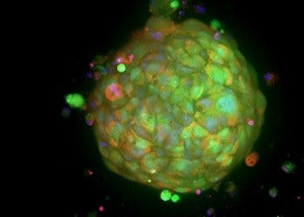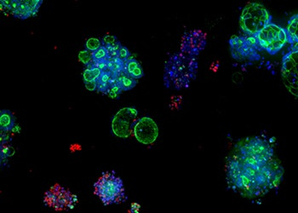
Patient-derived organoids (Tumoroids)
Patient-derived organoids (PDO) for oncology research
The use of patient-derived tumor tissue has transformed the field of drug and target discovery research, providing a translational tool and physiologically relevant system to evaluate tumor biology. There has been a transition from 2D assays to 3D cell model systems because they more accurately recapitulate the human in vivo environment and are a more predictive tool for drug discovery. An example of this is the use of patient-derived organoids (PDOs) for oncology research.
Patient-derived tumor organoids or tumoroids are cultures of tumor cells derived from individual patients. PDOs are generated from tumor biopsies or surgical procedures and can serve as models to understand patient-specific drug responses and investigate cancer cell growth. Digested tumor pieces and cells harvested from patient-derived tumors exhibit cancer stem cell (CSC)-like qualities and can be expanded over multiple passages to produce large numbers of organoids that maintain molecular characteristics of the original tumor.
Breast cancer and colorectal cancer are two of the most common and challenging types of cancer affecting patients worldwide. Here we showcase our featured patient-derived cancer organoid research. Our results demonstrate the superior potential of PDOs compared to other tissues in both precision medicine and high-throughput drug discovery applications, particularly when leveraging automation with high-content imaging and AI data analysis.

Breast cancer organoids
Early detection and treatment are crucial in the survival rate of breast cancer patients. This necessitates the use of clinically relevant tumor models to understand the mechanism, analyze tumor biomarkers, and screen anticancer drugs. Breast cancer tumoroids provide the platform to study tumor physiology and response to targeted therapies.
Breast cancer organoids are derived from patients’ primary breast tumor cells and incubated in multi-well plates. When integrated into automated drug screening workflows, breast cancer tumoroids can be used to screen large compound libraries to find lead compounds.
Automated imaging and analysis of tumoroids are also necessary for the quantitative assessment of phenotypic changes and dose-dependent drug responses. With immunofluorescence staining, tumoroids can be analyzed with an automated confocal imaging system to evaluate the dose-dependent effects of anticancer drugs. In addition, software tools can provide informative read-outs, such as tumoroid size, integrity (area), intensities for different marker expression levels, and cell count.
Learn more about Breast Cancer Organoids

Colorectal Cancer (CRC) Organoids
Patient-derived colorectal cancer organoids (CRC organoids or colorectal cancer PDOs) are multicellular mini replicas or “mini-guts” of the 3D tumor derived from patient tissues and grown in a research lab. They have been shown to retain in vivo characteristics of the original tumor and show drug responses that are similar to that of their derived organoids. This offers transformational possibilities for medical research and drug discovery.
Here we discuss the development, automation, and applications of patient-derived colorectal cancer organoids in high-throughput drug discovery. Our results show the superior potential of PDOs vs. other tissues in both precision medicine and high-throughput drug discovery applications when using automation with high-content imaging.
Learn more about Colorectal Cancer (CRC) Organoids
More great resources
Here we present our results for breast cancer disease modeling using PDOs formed from primary cells isolated from a patient-derived tumor. Learn how to analyze breast cancer tumoroid growth and the efficacy of anticancer treatments with high-throughput screening and high-content imaging solutions: